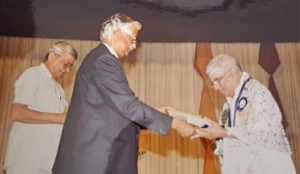
By T.S. Parthasarathy
Edited excerpts reproduced from the Music Academy Souvenir published when Vidwan K.P. Sivanandam was conferred the Sangita Kalanidhi title in 1992.
Chinniah (b. 1802), Ponniah (b. 1804). Sivanandam (b. 1808) and Vadivelu (b. 1810) formed the legendary Tanjore Quartet who carved for themselves a unique niche in the annals of Carnatic music and Bharatanatyam. Their grandfather was Gangamuthu, originally from Tirunelveli, and their father was Subbarayan of Chenganarkoil in the Thanjavur district. Gangamuthu was an expert natyacharya who revived many obsolete dance forms of Tamilnadu. He and his son Subbarayan were patronized by ruler Tulajaji of Thanjavur.
Bharatanatyam was the heirloom of the Quartet and they received training in music from no less a Guru than the great Muthuswami Dikshitar. They became the Asthana Vidwans of ruler Serfoji II and his successor Shivaji. Chinniah later went to Mysore Durbar and introduced the Tanjore style of Bharatanatyam there while the other three were patronised by Maharaja Swati Tirunal of Travancore. Vadivelu settled down at Trivandrum till the end of his life.
The advent of the Tanjore Quartet marked a new era in the history of Bharatanatyam as it led to the introduction of the present format of a recital, namely, Alarippu, Jatisvaram, Sabdam, Padavarnam, Ragamalika and Tillana. This is evident from the fact that they composed numerous compositions in Telugu, Tamil and Sanskrit in the same order which still form the backbone of Bharatanatyam concerts.
Among the four brothers only Sivanandam appears to have had sons. In this direct line came Sangita Kalanidhi Thanjavur K. Ponniah Pillai — a scholar, musician and composer in his own right. He adorned every position he occupied and rendered valuable service to Carnatic music and dance by publishing the compositions of his forbears in simple notation.
Vidwan Thanjavur K.P. Sivanandam, the president-elect of the 66th conference of the Madras Music Academy, is the second son of the late K. Ponniah Pillai, the first being Natyacharya K.P. Kittappa alias Sabhapati (b. 1913). Sivanandam belongs to the seventh generation in the direct line of the Tanjore Quartet.
Born on 1st March 1917, Sivanandam first learnt vocal music and Bharatanatyam from his grandfather, Natya Kalanidhi Pandanallur Meenakshisundaram Pillai and father Ponniah Pillai. He later had training in Veena from Vidwans Desamangalam Subrahmanya Iyer and Gomatisankara Iyer. He is a Sangita Bhushanam of the Annamalai University. At the age of 21 he joined the Annamalai University as lecturer in music and after serving for 11 years, became professor in the department of music, Tamilnadu Government which post he held for 20 years. In 1990 he was appointed as Dean of the Faculty of Fine Arts and head of the department of music in the Annamalai University and retired after a few years.
In 1980, Vidwan Sivanandam founded the Swami Vipulananda Isai Nataka Kalluri at Mattakalappu in Sri Lanka and served as its Honorary Principal. In addition he occupied many other distinguished posts. He has several publications to his credit like the Natya Isai Karuvoolam, Thanjai Peruvudaiyan Perisai and Adi Bharata Kala Manjari. He was a member of the Advisory Committee of the Music Academy for. many years and the recipient of many honours and titles.
Vidwan Sivanandam represents a great tradition, and had concert experience of several decades. He is noted for his chaste style and smooth play which are the results of intense sadhana. He had a vast repertoire of compositions by different composers. His way of handling the Veena was unique and the swaras that poured out were pure as crystals. His uncompromising adherence to tradition in the realm of music, where values are fast changing, was the hallmark of his music. His ragam, tanam, pallavis reveal his command over the sophisticated intricacies of rhythm.
His wife, Sarada Sivanandam, was a ‘Sangita Vidwan’ and a partner in his life as well as in his art. She was a professor of Veena for many years. She followed her husband like a shadow and their joint concerts were a treat alike to connoisseurs and lay rasikas.
Vidwan K.P. Sivanandam passed away on 30th July 2003.
Vainika Vidushi, Sangita Kala Acharya Dr. R.S. JAYALAKSHMI describes some of the salient features of vidwan K.P. Sivanandam’s veena playing:
Sangita Kalanidhi Vidwan K.P. Sivanandam and Sarada Sivanandam were a popular Veena duo of their time. Their style has many special features.
A look at their concerts and recordings reveals that they preferred rakti ragas. They took and handled ragas like Anandabhairavi, Neelambari, etc. for their main presentations and rendered tanam for these.
# Mayatita svarupini in Mayamalavagaula raga, Rupaka tala. A composition of Sangita Kalanidhi K. Ponniah Pillai, father of K.P. Sivanandam Pillai. It is one of the nine songs glorifying the great vaggeyakara Muthuswami Dikshitar, a guru of the Tanjore Quartet to whose lineage Sangita Kalanidhi Sivanandam too belongs.
# Aligite bhagyamaye — Kshetrayya padam in Husseni raga, Triputa tala.
# Vagaladi bodhanalaku — a javali composed by Tirupati Narayanaswami in Behag raga and Rupaka tala.
# Excerpts from a Ragam-Tanam by K.P. Sivanandam